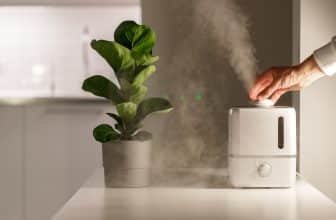Difference Between Air Humidifier and Purifier: Key Functions and Benefits
Choosing between an air purifier and a humidifier can significantly impact your home’s comfort and your health. Each device has its own unique function: an air purifier removes pollutants and allergens, making it ideal for dealing with issues like allergies and asthma. On the other hand, a humidifier adds moisture to the air, which can help with dry skin, static electricity, and respiratory conditions.

Understanding these differences is key to selecting the right device. Air purifiers work by pulling air through filters that trap various particles, improving overall air quality. Humidifiers, however, release water vapor to maintain a balanced humidity level, which is especially helpful during dry seasons or in climates with low humidity.
By differentiating the functions and benefits of each, you can make an informed decision tailored to your specific needs. Whether aiming to breathe cleaner air or find relief from dryness, knowing what each device offers will guide you in enhancing your indoor environment.
Key Takeaways: Difference Between Air Humidifier and Purifier
- Air purifiers remove pollutants and allergens.
- Humidifiers add moisture to the air.
- Choose based on your specific health and home needs.
Understanding Air Purifiers and Humidifiers
Air purifiers and humidifiers are designed to improve indoor air quality but in different ways. Air purifiers clean the air by removing pollutants, while humidifiers add moisture to the air, which can be especially beneficial in dry environments.
Essential Functions
Air purifiers are devices that remove contaminants from the air. They are especially useful for people with allergies, asthma, or other respiratory conditions. These devices typically use filters, such as HEPA filters and activated carbon filters, to trap dust, pollen, pet dander, and other airborne particles.
Humidifiers, on the other hand, add moisture to the air. They are commonly used in dry climates or during winter months when indoor heating can cause dry air. Humidifiers can help prevent issues like dry skin, nasal congestion, and static electricity. Some models use ultrasonic technology to emit a fine vapor that increases humidity levels.
Varieties of Purifiers and Humidifiers
There are several types of air purifiers, including those with HEPA filters, which are highly effective at capturing small particles. Another common type is the activated carbon filter purifier, which is excellent for trapping odors and chemical pollutants. Some air purifiers also use UV light to kill bacteria and viruses.
Humidifiers come in various types as well. Ultrasonic humidifiers use high-frequency vibrations to produce a fine mist. Evaporative humidifiers use a fan to blow air through a wet wick or filter, adding moisture to the air. Steam vaporizers heat water to create steam, which is then cooled before being released into the room.
Key Components
Air purifiers generally consist of one or more filters. HEPA filters are capable of trapping 99.97% of particles as small as 0.3 microns. Activated carbon filters are effective at removing gases and odors. Some advanced models incorporate multiple filtration stages to ensure thorough air cleaning.
Humidifiers have different components based on their type. Ultrasonic humidifiers include a metal diaphragm that vibrates at ultrasonic frequencies to create water droplets. Evaporative humidifiers utilize a wick filter that absorbs water, which is then evaporated by a fan. Steam vaporizers have a heating element that boils the water before cooling it to a safe vapor.
Air purifiers and humidifiers each serve distinct purposes, yet both are valuable for maintaining a comfortable and healthy indoor environment. Proper selection depends on specific needs, such as improving air quality or increasing humidity levels.
Health and Environmental Impact
Air purifiers and humidifiers both offer distinct benefits for health and indoor air quality. Knowing these benefits can help choose the right device for specific health needs and living conditions.
Alleviating Health Conditions
Air purifiers are designed to remove pollutants, allergens, mold spores, and bacteria from the air. This makes them particularly valuable for individuals with asthma, allergies, or other respiratory conditions. They use HEPA filters to trap tiny particles like dust mites, pet dander, and mold spores, which helps in reducing asthma and allergy symptoms.
Humidifiers add moisture to the air, which can be beneficial for those with eczema or other skin conditions. Dry air can lead to itchy skin and worsen eczema. Humidifiers can also help with respiratory issues by keeping the airways moist, making it easier to breathe, especially during cold and flu seasons.
Influence on Indoor Air Quality
Air purifiers significantly improve indoor air quality by filtering out harmful particles, including volatile organic compounds (VOCs) and smoke. This can be crucial for people in environments with high indoor air pollution or for those who smoke. Using an air purifier can create a healthier living space by reducing exposure to harmful contaminants.
Humidifiers, while not removing pollutants, help maintain an optimal humidity level, preventing the growth of mold and minimizing the presence of dust mites. Proper humidity can also lower the survival rate of viruses like COVID-19 in the air. The Environmental Protection Agency recommends maintaining indoor humidity levels between 30-50% to achieve the best results for health and comfort. Maintaining the right humidity level can also protect wooden furniture and musical instruments from cracking and warping.
In summary, air purifiers and humidifiers both contribute to a healthier living environment but do so in different ways. Understanding these differences can help in making an informed decision based on specific needs and conditions.
Practical Insights for Usage
Choosing whether to use an air purifier or a humidifier depends on specific needs such as allergy relief or moisture levels in the home. Understanding how to optimize placement and maintain each device can enhance their effectiveness.
Optimizing Placement and Maintenance
Placement of these devices plays a crucial role in their efficiency. Air purifiers should be placed where airflow is frequent, such as near doorways or windows, to maximize air cleaning. In contrast, humidifiers are best positioned in central locations within a room to evenly distribute moisture.
Regular maintenance is essential. Clean the air purifier’s filters regularly to prevent clogging. For humidifiers, use distilled water instead of tap water to reduce mineral deposits and clean them weekly to prevent mold growth. Monitoring humidity levels is also important; aim for a relative humidity between 30-50% to avoid excessive dampness or dryness.
Considerations for Specific Conditions
Different health conditions can dictate the use of either device. Those with allergies or asthma benefit greatly from air purifiers as they remove pollen, dust mites, and pet dander from the air. These devices are particularly useful during allergy seasons when these irritants are more prevalent.
On the flip side, individuals with dry skin, dry throat, or nasal passages find relief using humidifiers. Adding moisture to the air can alleviate symptoms like coughing and sneezing. This is especially beneficial in winter or in climates with low humidity, where indoor air is often dry due to heating systems.
When to Use Each Device
Use an air purifier if indoor air quality is poor or if household members suffer from respiratory issues such as asthma or allergies. They are excellent at removing pollutants like smoke, pet dander, and other airborne particles. A good option is one that utilizes a HEPA air filter for maximum efficiency.
Humidifiers, on the other hand, should be used when air moisture levels are low. These devices are ideal for homes in dry climates or during the winter when heating systems can dry out the air. They help maintain a comfortable living environment, preventing issues like dry skin and dry nose. Always monitor moisture levels to ensure they stay within a healthy range.
Analysing the Differences
Air purifiers and humidifiers serve distinct functions, making each better suited for different needs within a home. Knowing how they differ can help you make informed choices based on your specific requirements.
Functional Distinctions
Air purifiers are designed to clean the air by removing pollutants, allergens, and contaminants. These devices use various types of filters, such as HEPA filters and activated carbon filters, to trap particles like pollen, pet dander, and smoke. They are ideal for individuals with allergies, asthma, or other respiratory issues as they create a cleaner breathing environment by eliminating airborne irritants.
Humidifiers, on the other hand, add moisture to dry air, which can be caused by central heating or air conditioning. Dry air can lead to issues such as dry skin, static electricity, and worsened symptoms of colds or flu. Humidifiers are particularly useful in homes with children or babies and help maintain a comfortable humidity level, preventing the air from becoming too dry.
Choosing Between Humidifiers and Purifiers
When deciding between an air purifier and a humidifier, consider your primary needs. If you are dealing with allergies, asthma, or want to remove contaminants like pollen, pet dander, and smoke from your home, an air purifier is the optimal choice. These devices can significantly improve air quality and reduce respiratory problems by capturing harmful particles.
If your concern is more about alleviating symptoms caused by dry air, such as dry skin or respiratory discomfort during colds or flu, a humidifier would be more beneficial. Humidifiers are particularly useful during winter months when indoor air tends to be dry due to heating systems. They can also help in homes with children and pets, where maintaining proper humidity levels is essential.
Combined Solutions
In some cases, using both an air purifier and a humidifier might be beneficial. This combination can provide both clean and properly humidified air, addressing a wider range of indoor air quality issues. For example, while the air purifier filters out allergens and pollutants, the humidifier adds the necessary moisture to prevent dryness.
Families with children, babies, or pets might find this dual approach especially helpful. It ensures the air is free from irritants and maintains a comfortable humidity level, providing a healthier and more comfortable living environment. Remember to place the devices appropriately to optimize their functions without interference.
Addressing Common Concerns

To make an informed decision about choosing between an air purifier and a humidifier, it’s important to understand how each device handles different health and safety issues.
Handling Minerals and Microorganisms
Humidifiers can sometimes emit minerals and microorganisms into the air, especially if not maintained properly. Hard water can leave mineral deposits in the device that are then released as white dust. Regular cleaning and using distilled water can help reduce this risk.
On the other hand, air purifiers with HEPA filters are designed to trap particles, including dust and microorganisms, ensuring cleaner air. It’s important to remember that some purifiers use ionization or ozone generators, which might produce small amounts of ozone, potentially leading to respiratory irritation if not properly managed.
Efficacy of Air Treatment Devices
Air purifiers excel at removing contaminants such as dust particles, VOCs, and allergens. They can significantly improve air quality, making breathing easier for those with allergies, asthma, or other respiratory issues. Devices with HEPA filters are particularly effective.
Humidifiers improve air quality by controlling humidity levels, which can help alleviate respiratory symptoms like sinus congestion and dry skin. Different types of humidifiers, such as cool mist and warm mist, offer various benefits depending on the situation. For instance, warm mist humidifiers can reduce the likelihood of mold growth.
Safety and Additional Features
Safety is essential when choosing air treatment devices. Humidifiers should be regularly cleaned to prevent mold and bacteria from growing in the water tank, which can then be dispersed into the air and cause respiratory infections. Using a hygrometer can help maintain optimal humidity levels to prevent mold and dust mites.
Air purifiers should be chosen carefully to avoid models that produce ozone, as ozone generators can lead to eye irritation and inflammation of the airways. Modern purifiers often come with additional features such as timers, air quality sensors, and multiple filtration stages to enhance their efficacy while ensuring safety.
Dehumidifiers can also be useful in controlling humidity, especially in arid climates or areas prone to excess moisture, preventing the conditions that encourage mold growth. Understanding these features and maintenance needs ensures that users get the most benefit while maintaining a safe home environment.
By addressing these common concerns, individuals can better determine which device—an air purifier or a humidifier—best suits their needs and health circumstances.
Frequently Asked Questions
When comparing air purifiers and humidifiers, it’s important to know their effectiveness for allergies, sinus issues, and overall use in different environments including for babies.
What is the effectiveness of air purifiers vs. humidifiers in relieving allergy symptoms?
Air purifiers are effective in removing allergens such as dust, pollen, and pet dander from the air. This makes them ideal for individuals with allergies.
Humidifiers, on the other hand, add moisture to the air, which can help alleviate dry nasal passages but do not remove allergens.
Can air purifiers or humidifiers help alleviate sinus issues better?
Air purifiers trap airborne particles that can irritate sinuses, providing relief by reducing common irritants.
Humidifiers help by keeping nasal passages moist, which can prevent sinus congestion and dryness, especially during winter.
What’s the difference between air purifiers and dehumidifiers, and which one should I use?
Air purifiers clean the air by filtering out pollutants and allergens. Dehumidifiers reduce excess moisture, preventing mold and mildew growth.
Use an air purifier if you need cleaner air. Choose a dehumidifier if you have issues with high humidity levels in your home.
How do air purifiers and humidifiers affect a baby’s environment?
Air purifiers can help protect babies from airborne pollutants and allergens, creating a cleaner breathing environment.
Humidifiers can ensure the air is not too dry, which helps keep the baby’s skin and nasal passages from becoming irritated.
Is it more beneficial to use an air purifier or a humidifier to prevent the spread of COVID-19?
Air purifiers equipped with HEPA filters can capture particles, including viruses, which may help reduce airborne transmission.
Humidifiers do not remove particles from the air but maintaining proper humidity levels can potentially reduce virus survival rates on surfaces.
Can using an air purifier along with a humidifier improve sleep quality, and is it safe?
Using both devices can be beneficial. Air purifiers can remove airborne irritants that may disturb sleep, while humidifiers keep the air moist, preventing dryness.
It is generally safe to use both devices together, and doing so may help improve overall sleep quality by creating a comfortable sleeping environment.






